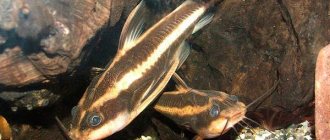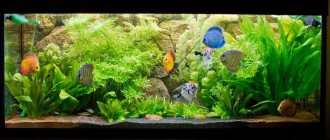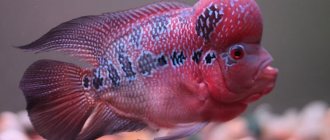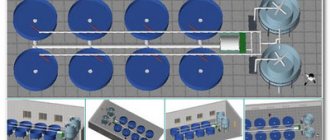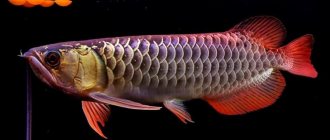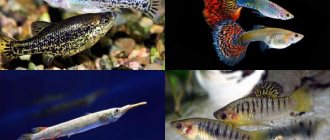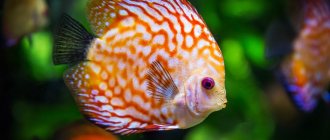What to feed aquarium fish?
Answer: Forty years ago such a question did not arise. There was one store in the whole city that sold fish, hamsters, balls, fishhooks, and food for all this. The store was called “Sporting Goods”, and was standard throughout the USSR. This numerous assortment was placed on 100 square meters of retail space. And only if he was in a regional center. Well, if it was the capital of the republic, then maybe more. The only food for aquarium fish was daphnia. To diversify the diet of pets, I had to go to the central market to buy pipefly, which lived in the refrigerator for a maximum of three days. And then, if you wrap it in newspaper, do not forget to wet it and rinse it regularly, removing dead larvae. Which was very difficult to do, given the size of the tubifex. Seasoned aquarists caught cyclops in puddles, brought ciliates from the river, washed bloodworms in the swamps - as long as the fish were healthy and happy, so that they would breed a lot and happily. Now the choice is quite large, but for some reason my fish feel much worse than they did in those days. I bought bloodworms. I fed the fish - the rhodostomuses died. I bought chips, no one will chew them until they fall. Except for the catfish, which lies at the bottom and waits for them to get wet. Then he reluctantly probes and absorbs it. Or maybe it was for the best that only the catfish ate? Is this why my favorite catfish, which lived happily at the bottom of the aquarium for more than 10 years, suddenly began jumping out of the aquarium at night? And one morning I found him with his belly floating up. Now tell me how to feed the remaining fish with these chips? Although angelfish grab it with pleasure if I first crush it. Well, the angelfish, for example, is not as pitiful as the julidochromis. Angelfish are not that rare; they can be bought on every corner. Fortunately, there are a lot of pet stores, not like in my distant childhood – you had to go to the city center to buy fish. Although... Julidochromis do not attack chips as furiously as angelfish. And the herbivore will generally give his soul for a plate food called “Bionorm”, which contains dried vegetation. He would eat only grass, and would feel quite wonderful if the aquarium stood in the sun and became overgrown with thread algae. This fish doesn't need anything else. But this cannot be done, in order to avoid water blooms and putrefactive fermentations. Yulidochromis are waiting for an additional portion of snails to fall into the water, because they have eaten the old ones to empty shells. They only dream about when a lot of new, soft-bodied, weak-shelled slugs will breed, because nothing tastier for them has yet been invented in my limited water space. After many years of observing aquarium fish, and I have been doing this since childhood - more than 50 years - I came to the conclusion that it is necessary to study each species in order to choose food for them. If you love your fish, you will do this without stress, with great pleasure. And, even if your favorite fish are piranhas, you will also feed them. Other fish, not my favorite ones. There are others like that. For example, I have a guppy. I don’t feel sorry for them, even kill them! They resemble cockroaches: they eat a lot, shit a lot, breed continuously, and eat their children with great pleasure. And some people also like guppies, I won’t argue. I started with them - with five pieces and one round 20-liter aquarium. A year later, I already had 5 such aquariums, and I constantly “delivered”, placing the fry in the “nursery”, then in the “kindergarten”, watching how the fry turned into females and males, what colors and tail length the males acquired. Then she killed in search of food all weekend, just so that these tails would become brighter. You can say that I have been involved in selection since childhood. This is a fun activity for kids, let me tell you. As well as the selection of food and monitoring the process of feeding the fish. If you love them, of course. Yes, and one more important tip: look for the expiration date and release date of dry food. I didn't find this on a can of chips. The food is quite expensive, it was purchased during the “quarantine”, when all pet stores were closed and only one hypermarket was open, and there was nothing to feed the fish. Now I doubt it: it’s a shame to throw away the food, and the shelf life is 24 months. But it is dry, without signs of mold, nothing has grown in it, no larvae. It looks and smells nice, so let them eat for now. And in the spring I’ll take it to the crucian carp for complementary feeding if there’s anything left after I swallowed it.
Often, aquarium owners are faced with the fact that their inhabitants begin to eat the leaves and stems of plants, which negatively affects the appearance of the underwater flora and often leads to growth stagnation and even death of some plant species. In addition to the fact that plants are undoubtedly a magnificent decoration of the underwater landscape, they play an important role in maintaining the biological balance in the aquarium. During the process of photosynthesis, plants not only saturate the water with oxygen but also absorb nitrogen compounds, which are formed as a result of the vital activity of fish and, if in excess, can become toxic to the inhabitants of a home pond.
Before you start decorating an aquarium, you need to think about what kind of fish it will be inhabited. Get acquainted with their lifestyle in their natural habitat, as well as their food preferences. To what size do certain individuals grow and what niches of the reservoir do they inhabit?
Reasons why fish eat aquarium plants
Plants and fish in their natural habitat exist in peaceful proximity, supporting each other's development. However, in an aquarium environment this connection may be disrupted.
Many people face the problem of fish eating aquatic plants, but scientists have still not been able to come to a common conclusion as to why this happens. There are usually several reasons.
Lack of vegetable protein in the diet
Lack of vitamins, mainly groups B and E (tocopherols and tocotrienols). This manifests itself in the form of various defects. (For example, underdevelopment of the gill covers in young individuals.) This problem can be solved by adding complex vitamins to the food, for example, AQUAYER. And also using professional food for herbivorous fish in the diet, such as Tetra Phyll.
For chain catfish (Ancistrus, Loricaria, Sturisome, Otocinclus, etc.), it is necessary to feed scalded vegetables (cucumbers, zucchini, eggplant, broccoli, lettuce, spinach and nettles).
Vegetables can be cut into slices and secured to a suction cup with a holder so that they do not float up.
Uneaten remains must be promptly removed. And also remember that they need fiber for proper digestion. The main substance from which the walls of wood cells are built. Therefore, natural driftwood in aquariums with these fish is necessary.
A special type of fish
Species of fish whose diet consists almost entirely of plant foods. (Pacu, Metinnis, African cichlids), as well as all varieties of goldfish, are not suitable for keeping in underwater gardens. However, even for these fish, you can choose types of plants that are either not to their taste or too tough for them. These are all types:
- Anubiasov
- Ferns
- Bolbitis gedelota
- Bolbitis heteroslita
- Thailand fern
- Various crinums
- Giant Vallisneria
- Aponogetones
- Rdest
- Elodea
- Hornwort
Author: · Published 02/01/2020 · Updated 06/30/2020
How to choose the right food for aquarium fish
Today there are many treats for underwater inhabitants. The main task is to find out what kind of food is suitable for the fish you have.
Feeds that promote rapid growth must have a large amount of protein. Energy is provided by fats and carbohydrates. To strengthen the immune system and form the skeleton, food must contain a sufficient amount of vitamins and minerals.
To keep your fish from getting sick, you should diversify their menu. It is better to alternate 2-3 products made from insect larvae, small pieces of fresh vegetables or special vitamin preparations - it depends on the type of fish.
If the fish eat the treat quickly and with appetite, rest assured that the ingredients were selected correctly. But you shouldn’t overfeed your pets. Adults should consume 2-5% of their weight per day, fry - up to 1/3.
Causes
Whether or not a fish's loss of appetite should be a cause for concern depends on the specific circumstances.
- It is completely normal for fish that have just been introduced into the aquarium to show no interest in food for some time (several hours or days) due to the stress associated with transportation and adjusting to the new environment. Such fish may refuse to eat even if the food is unfamiliar to them. The same can apply to fish that have been living in an aquarium for a long time if you offer them unusual food. This problem is solved when the fish begins to feel hungry. But before this, all uneaten food must be carefully removed from the aquarium to avoid water contamination.
- Some fish require special foods and will refuse any alternative food. For example, some predatory fish will sometimes reject anything other than live fish, at least initially.
- Fish that incubate eggs in their mouths usually stop feeding during the spawning period.
- In fish that have been living in an aquarium for a long time, reluctance to eat may be a sign of some kind of health problem. You need to do water tests, fix any problems, and then monitor the fish and see if it shows any additional signs of illness.
- If a fish takes the food it normally eats into its mouth but then spits it out, then the problem may be a foreign body stuck in the throat (this could be pieces of food, gravel, equipment parts, or a tumor). In this case, the fish must be caught with a net and its throat examined. Soft and smooth objects can sometimes be removed independently using long tweezers. However, veterinary assistance may be required and should be sought if the foreign body is sharp (such as some types of gravel) or has protrusions (such as an airway valve).
- Sudden loss of appetite and lack of bowel movements may indicate constipation. A few days without food usually does not cause any harm to the fish, except for the fry, which can quickly die of starvation.
Types of food for aquarium fish
To choose high-quality, and most importantly, suitable food for your pets, you need to understand the assortment:
Dry food for aquarium fish and its types
They are inexpensive, economical to use, and easy to store.
Types of dry food for aquarium fish:
- tablets with plant or animal components immediately sink to depth under their own weight. Suitable for bottom fish (catfish of various species);
- The flakes are suitable for all breeds, but due to their low nutritional value they are used as a supplement. The flakes do not sink, so they feed on fish that can grab food from the surface (Guppies, Neon, Barbus, etc.);
- The granules are universal, like the previous food. They can float or sink (depending on the composition). They swell in water. Before feeding, they need to be soaked for 10 minutes so that they do not increase in size after swallowing and cause digestive problems;
- microfeeds are sold in the form of dust and are food for fry. They heavily pollute the aquarium (require frequent water changes).
Live food for aquarium fish
Live food contains large amounts of protein, which promotes growth and reproduction. You should be careful about storage and purchase from trusted suppliers so as not to introduce infection into the aquarium.
The cockerel does not eat and moves little
Often, a betta's refusal to eat can occur in an adapted and long-established fish. This is observed in the case of a sharp change in housing conditions (temperature, water condition, etc.) and is accompanied by quite serious consequences for the health of the fish. This is explained by a sharp decline in the body’s protective functions, and with it the ability to withstand new environmental challenges, including dangerous infections.
Hypothermia, low water temperature
The impact of low temperatures has a depressing effect on the activity of living creatures, and the aquarium betta fish is no exception. A decrease in water temperature below +24 °C is dangerous for its successful existence. This is due to the fact that in its natural environment this creature lives in hot equatorial waters, with fairly high and stable temperatures throughout the year.
A decrease in water temperature to +20 °C and below signals the fish’s body about the onset of an unfavorable period, as a result of which the processes of inhibition of metabolism are launched, and with this the activity of organs and systems. In this way, the body tries to switch to an autonomous mode with low nutrient consumption, the so-called suspended animation, which helps it survive an unfavorable period. As a result of this, the mobility of the cockerel decreases, and a complete or partial refusal of food is observed. But most often, a decrease in temperature causes a cold in the fish, accompanied by a sharp suppression of the immune system. As a result, fasting becomes one of the symptoms of a cold, which, if not treated in a timely manner, can have a detrimental effect on the health of the betta.
Bad food
Various representatives of aquatic fauna are highly susceptible to all kinds of chemical compounds, toxicants, etc. Even small proportions of substances can have a detrimental effect on their health, therefore, during the course of evolution, fish have learned to skillfully distinguish them in any food. This is a natural necessity that has helped them successfully survive in nature to this day, therefore, when fed with low-quality or contaminated food, the betta can often quite calmly refuse food until high-quality food appears in the aquarium.
Despite the fact that these representatives of aquatic fauna are considered omnivores, they feed on fresh and clean food, as well as exclusively pre-prepared foods (chopped to the required size). To distinguish low-quality or harmful food, you need to take a good look at the behavior of the fish at the time of feeding. If your betta takes an active interest in feeding, timidly tries food and then rejects it, you should seriously think about changing the food or diet, especially if you decide to include something new in your betta’s food.
Where and how to store fish food
Typically, dry food is sold in sealed bags or other containers. It should be stored in a cool, dry place, tightly closed in a light-proof container. You need to purchase such a quantity to use it no later than 3 months. When purchasing, pay attention to the expiration date.
Frozen food is especially popular among aquarists. They are subjected to gamma irradiation at the production stage, so they are safer for fish than their live counterparts. They should be stored in the freezer. Before feeding your pets, you need to let the food thaw under running cold water and strain.
Unfortunately, live food does not last long. It can be kept in the “warmest” compartment of the refrigerator in a plastic container for a maximum of several days. Place a damp white cloth inside so that the ends hang down. The feed is laid out in a thin layer, leveled and covered with the ends of the fabric. The container should be loosely covered with a lid. Plankton must be periodically washed in a net under running water.
What food is best for aquarium fish?
When selecting food, you should keep in mind that the main goal should be to help, not harm. We need a composition that does not degrade water quality. Many cheap feeds, when soaked, settle on the bottom, plants, and filters. They pollute the environment and, when decomposed, can poison it.
When choosing, you should adhere to certain rules and take into account the preferences of certain breeds.
Viviparous inhabitants of the aquarium are not very picky about food. In nature, they feed on live food, so bloodworms, tubifex, etc. are suitable. Do not forget about plant foods (dried nettle, spirulina). It is easier to purchase special mixtures that do not pollute the water. The food should not be large in order to be evenly distributed throughout the entire aquarium.
Predators, when hungry, attack each other, so the basis for them is live food (various worms, etc.). If this is not available, it is allowed to feed raw meat or fish.
Bottom-dwelling fish feed on what sinks. Their favorite treat is dry tablets. You need to feed with plant (lettuce, cucumber) and animal (bloodworm, coretra) proteins.
It is recommended for the little ones:
Rotan
Many fishermen really don’t like rotan. He looks unattractive and even unpleasant. But they deserved such hostility not only because of their appearance. Rotans are not liked because of their harmful nature. They swallow any bait, they can get caught on an empty hook and swallow it very deeply. Removing rotan from the hook is another problem.
Many people do not want to cook the rotan they come across; they throw it away or give it to animals. But this is in vain. People who have overcome feelings of hostility and disgust claim that rotan tastes no worse than any river fish and may even be better. Rotana can be fried and smoked, and baked into pies.
ds03.infourok.ru
Rotan meat is no worse than that of noble river fish. Another advantage is that it is devoid of small bones.
Find out more about rotan and why no one respects it from the following video.
How long can you not feed aquarium fish?
In order for the body of aquarium pets to function normally, the feeding regime must be balanced. Many novice aquarists often overfeed their pets. Therefore, periodically you need to arrange “fasting” days. It should be taken into account that for different breeds the number of fasting days without harm to health should be different.
Cichlids, catfish and Neons cannot go more than 1 week without food. The fry require a lot of food and will not survive fasting for more than 4 days. Locarium catfish and algae eaters can go without food for up to 10 days.
The ideal solution for when you're away is an automatic feeder that can be set to specific feeding times and portion sizes. The only drawback is that it only serves dry food.
Don't forget the rule! Underfeeding is better than overfeeding.
What are the dangers of fish that are too old and big?
The larger the fish, the longer it lives and, accordingly, accumulates more heavy metals. There is only one principle - try not to buy very large fish, advises nutritionist, allergist-immunologist, therapist and preventative medicine doctor Antonina Savolyuk.
Some people like it hot: doctors talk about the dangers of tea
Experts named people who should not abuse this drink
— If you don’t want to learn the list of fish [with high mercury content], rely on this relationship: a big fish means it has grown for a long time. And it doesn’t matter whether in the wild or in cages,” she emphasizes in an interview with Izvestia. — There are risks in both cases: in wild conditions - heavy metals, in artificial cultivation - pesticides and antibiotics that could be added to the feed.
Author of the quote
Heat treatment does not solve the problem. Heavy metals are heavy for that reason: they are stable, poorly bound and excreted. To remove them from the body, a whole chain of various chemical reactions is needed.
The fish should not only be washed and processed, but also left in the water for a while to protect itself, says Antonina Savolyuk. Heavy metals will not disappear, but water-soluble compounds from farmed fish (for example, some antibiotics) will.
Toxic Seven
Photo: Depositphotos/lenawurm
Hidden threat: Putin named the cause of the mine accident in Kuzbass
What measures will be taken in Russia after the tragedy and why the president is dissatisfied with the report of Minister Kotyakov
“But still, if you doubt the quality of the fish, it is better not to buy it at all, because the above methods are not effective enough,” adds Izvestia’s interlocutor.
There is good news: modern man has learned to inactivate heavy metals with the help of intestinal microflora: “If you have a healthy microbiota, the body itself will remove those relatively small doses of heavy metals, which also come from fish.”
It is important to note that the presence of heavy metals does not interfere with the absorption of nutrients, adds the nutritionist. Fish is saturated, firstly, with Omega-3, polyunsaturated fatty acids, which are scarce in other products. Secondly, it contains trace elements such as selenium and chromium, which are also quite rare.
“We are also talking about valuable amino acids: they are found in other products of animal origin, but they are not so easy to extract from meat,” explains Antonina Savolyuk. “In addition, essential amino acids contained in meat are less easily digested (this requires more active digestive enzymes), but they are absorbed much easier from fish. Therefore, it is recommended for dietary nutrition.
How to make food for aquarium fish at home
You can make your own plant food. Make a salad of nettles, boiled cabbage and aquarium duckweed. Grind everything in a meat grinder and keep in the freezer until thickened, then grind and store frozen.
Meat food is prepared from lean fish, seafood with the addition of beef or pork liver. The resulting set is mixed in a mixer, laid out on a smooth surface and dried. Store in a cool, dry place in a closed container.
Why shouldn't you overfeed your fish?
The most important reason why you should not overfeed fish is harm to health. When overfeeding, it is very easy to damage any internal organs of the fish and the fish may die. This occurs due to the fact that a large amount of food enters the body and the fish’s organs can literally burst.
Most aquarium fish do not feel full and will eat only as much as is given to them.
This is especially true for viviparous fish. Personally, in my practice, there were cases when a fish’s belly burst right before our eyes and the fish died.
Snakehead
The snakehead is a river predator that can eat any fish smaller than itself. It feeds not only on fish; its diet may include small forest animals, mice, voles and shrews.
Not all fishermen agree to eat snakehead. Many do not consider him a fish at all due to some of his abilities. It is known that this creature can move freely on the ground, moving from one body of water to another located nearby.
https://s.fishki.net/
Look at the photo of the snakehead. Do you think he looks like a fish or a snake?
What to do if the fish has eaten too much?
I overfed my fish more than once and developed a number of rules for myself, which I will gladly share:
- Change water at short intervals. For example, I change 20 percent, then after 3 hours another 10 percent. And the next day another 15 percent.
- Along with the change, I collect the remaining feed.
- Increased aeration.
- Fasting day.
We will also consider the right paths for popular fish.
What to do if you overfed your cockerel?
As a rule, males live in small aquariums, so when overfeeding, the first thing to do is collect the remaining food.
The second step is to change the water. Ideally, the entire volume, if it is possible to take water from another aquarium. If this is not possible, make changes every 3-4 hours by 20-30 percent until you change the entire volume. If the aquarium is very small (up to 3 liters), then it is better to change 80% of the water and fill it with settled water. You can add aquarium chemicals for water treatment. In general, the volume of replacement depends on how much the fish were overfed. But the above values can be taken as average data.
The third step is a fasting day. After the change, do not feed the betta for 24 hours.
Video
Why AQUARIUM FISH DO NOT EAT FOOD
What to do if the red-eared turtle does not eat
I bought a fish at the market and it doesn’t eat food.
The child does not eat. What to do. First steps. Natalia Chernega Baby Nutrition School
The fish is sick and won't eat anything! WHAT TO DO???
ZOO-portal EXOTICS
